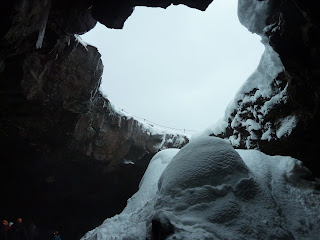In my previous post, I wrote about the Hellisheiði Geothermal Power Plant and the Friðheimar Greenhouse, which we respectively visited before and after visiting traditional Golden Circle sites on our Gate 1 Travel tour. In this post, I focus on our observations related to visiting the three sites traditionally associated with the Golden Circle: Þingvellir National Park, Geysir geothermal area, and Gullfoss waterfall.
Þingvellir National Park
Because the Icelandic 'Þ' character is pronounced like "th" in English, one often sees Þingvellir National Park spelled "Thingvellir" on blog sites and articles written in English.
The overlook near the visitors center has some impressive views!
From the observatory point near the visitors center, one can walk down into the valley-like area.
There are more impressive winter views down in the valley area!
Þingvellir National Park is a beautiful park and it's interesting to see how the tectonic plates of North America and Eurasia are separating here. This is also a historically significant park:
No single place epitomizes the history of Iceland and the Icelandic nation better than Þingvellir by the river Öxará.
At Þingvellir - literally "Assembly Plains" - the Alþing general assembly was established around 930 and continued to convene there until 1798. Major events in the history of Iceland have taken place at Þingvellir and therefore the place is held in high esteem by all Icelanders. Today Þingvellir is a protected national shrine. According to the law, passed in 1928, the protected area shall always be the property of the Icelandic nation, under the preservation of the Alþing.
Geysir Geothermal Area
Our next stop on the tour was the Geysir Center to have lunch and see the geysers.
There are multiple restaurant options at the Geysir Center and we selected Kantina, which is described as "a fast service restaurant specializing in an honest and affordable menu." We chose it (fish and chips) to ensure that we had plenty of time to see the geyser before leaving for our next stop. I liked that the fish and chips was a large fried fillet of fish rather than pieces of fish.
The geothermal activity in this area is obvious even before seeing the geyser.
The area has a barren beauty about it.
Geysir ("The Great Geysir") is largely inactive now, but is still well-known for being the name from which the term "geyser" has been derived.
Fortunately, nearby Strokkur geyser is still active.
This geyser may not typically shoot as high into the air as Geysir once did, but it's frequency (every five to ten minutes) is convenient.
Only needing to wait several minutes for it is nice, especially when compared to waiting much longer for "Old Faithful" in Yellowstone National Park.
The boiling water forms a blue "bubble" effect immediately before the eruption.
Strokkur does not erupt as high as Old Faithful, but it's still always incredible to see the power of this hot water shooting out of the earth.
I suspect that seeing Strokkur erupt would be even more special for those who have not seen a geyser before. As I've finally started to travel to other areas of the world and enjoyed and appreciated their beauty, I've also been reminded of how many great places I've been able to experience in the United States, but have taken for granted because they were "close to home." I've been to Yellowstone National Park multiple times and am reminded to not take it for granted. Strokkur is well worth the visit, especially as part of the Golden Circle. In fact, it's just a short drive away from the last major stop in the Golden Circle that will be covered in this post: Gulfoss Waterfall.
Gulfoss Waterfall
I'm a big fan of waterfalls and feel privileged to have been able to see Niagara Falls within a few months of seeing three of Iceland's better known waterfalls: Seljalandsfoss, Skógafoss, and Gulfoss. We saw the first two of these Iceland waterfalls while driving to Vik and back, but we saw Gulfoss ("golden falls") on the Golden Circle tour. Although all three waterfalls are magnificent, Gullfoss was my favorite and reminded my of Niagara Falls.
Gulfoss is said to be "one of Iceland's most beautiful and without a doubt Iceland's most popular waterfall."
Conclusion
It's easy to understand why the Golden Circle is such a popular tourist attraction in Iceland. In a single day with only 4-5 hours of daylight, we were able to see the magnificent sights of Þingvellir National Park, Strokkur geyser and Geysir geothermal area, and Gulfoss waterfall. Our Gate 1 tour book-ended these outdoor wonders with visits to Hellisheiði Power Plant and Friðheimar Greenhouse to make it a packed day of beautiful natural sights and interesting information about Iceland's ability to adapt to its environment.
































































